As companies grow, they’re faced with the challenge of keeping team members aligned on the same mission. But every group of employees has a unique set of priorities, and providing them with the support they need to drive business results isn’t always a straightforward process.
Read on to learn how managers and leaders can use OKRs (or objectives and key results) to create accountability, transparency, and alignment within their organizations.
Introduction to OKRs
As a core component of any performance management plan, goal setting helps businesses overcome the challenges of scaling their workforces. OKRs are a popular goal-setting framework that businesses use to define and measure progress across different levels within the organization. When used effectively, OKRs spark innovation, unite teams, and create a clear path for taking companies to the next level.
While there have been a number of goal-setting frameworks throughout history such as SMART goals, OKRs were first introduced at Intel by management scientist Andy Grove and later popularized by Google in the late 1990s. Today, OKRs power thousands of organizations from Spotify and Amazon to the United States Navy.
How OKRs Drive Business Results
OKRs help businesses manage performance in five core ways:
- Alignment: OKRs get everyone on the same page around what teams are doing, why they’re doing it, and how their work moves the organization forward.
- Prioritization: OKRs bridge the gap between long term goals and the daily work necessary to achieve them. This empowers employees to prioritize day-to-day tasks and long-term initiatives.
- Transparency: OKRs foster transparent company cultures by informing everyone of the impact and priorities of teams and individuals across the organization, top-down from the CEO to the intern.
- Accountability: OKRs create ownership of performance expectations and remove any room for gray areas as to who’s responsible for meeting specific goals.
- Empowerment: OKRs show employees the impact of their work and give them a sense of ownership over their progress.
The Anatomy of OKRs
As a proven goal-setting framework for companies of all sizes, OKRs are effective because of their basic structure and practical application. Here’s an overview of how they work.
Structure
OKRs divide goals into achievements and the actions that support them. They are structured around two fundamental questions:
Objective: Where do I want to go?
The Objective is the goal of the entire organization, team, or individual. Objectives are typically qualitative and set the direction for what every level of the business wants to achieve in a certain amount of time.
Key Result: How will I get there?
Key Results (KRs) are the measurable outcomes that need to be achieved in order to meet the objective –– somewhat like a “to-do list” for accomplishing an overall goal. KRs help track progress and are generally metrics-driven, using the team’s key performance indicators.
Application
The main benefits of OKRs are largely based on the way they are put into practice and applied across organizations.
ORGANIZATIONAL LEVELS
Individual and team goals should be connected via measurable key results to high-level company objectives. This interplay of business goals boosts employee engagement and creates overall business alignment.

ALIGNMENT
Every company should aim for OKR alignment between organizational and team levels, but there are two different approaches companies can take to achieving it:

Strict alignment: In this approach, key results translate directly into the objectives of the level below them.
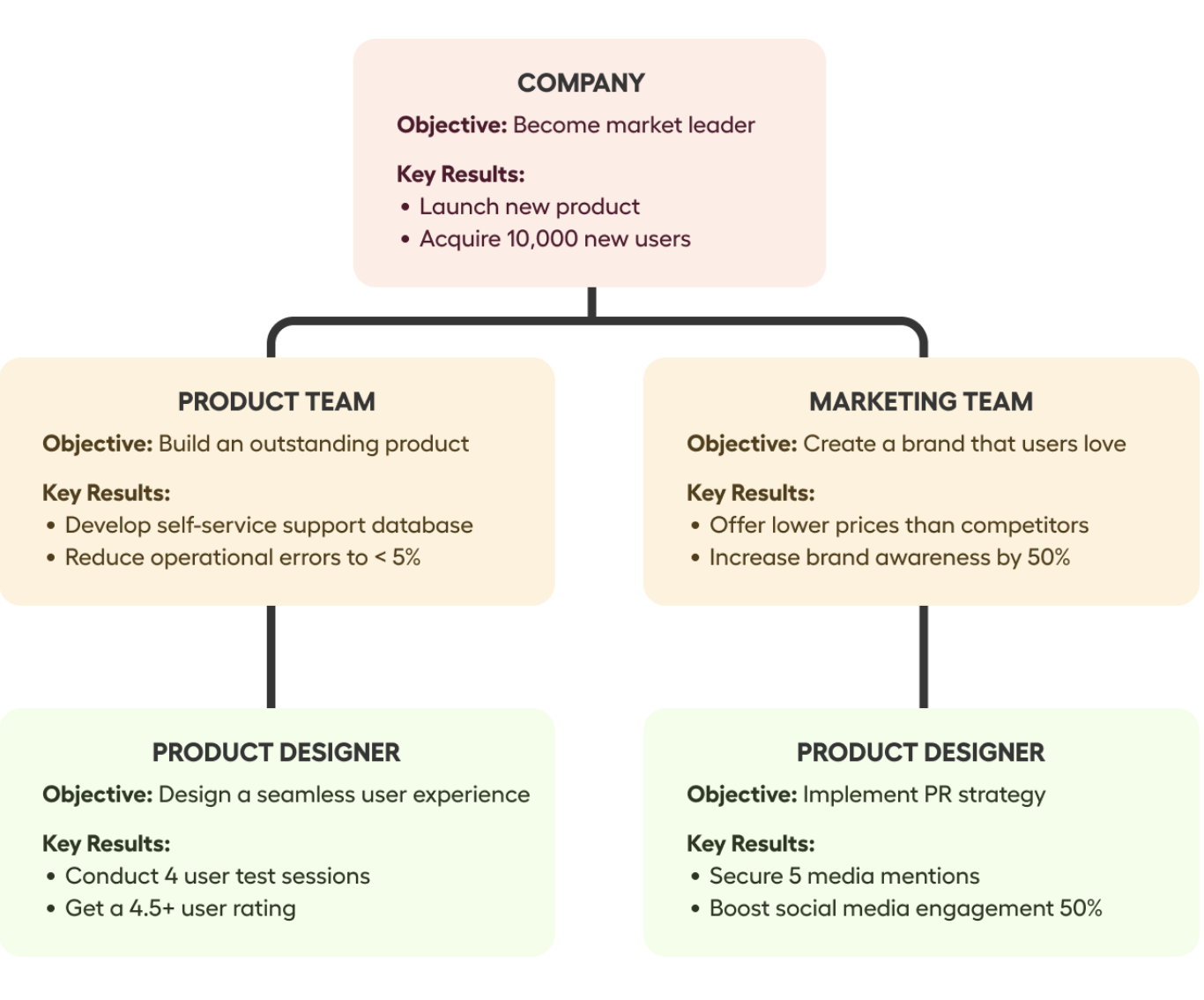
Directional alignment: In this more flexible approach, organizations establish objectives that feed into the key results of higher levels but don’t mirror them exactly.
WEIGHTED KEY RESULTS
Not all key results are created equal –– some have a bigger impact on progress than others. By assigning different weighted values to key results, businesses can account for the relative influence individual actions have on overall goal progress.
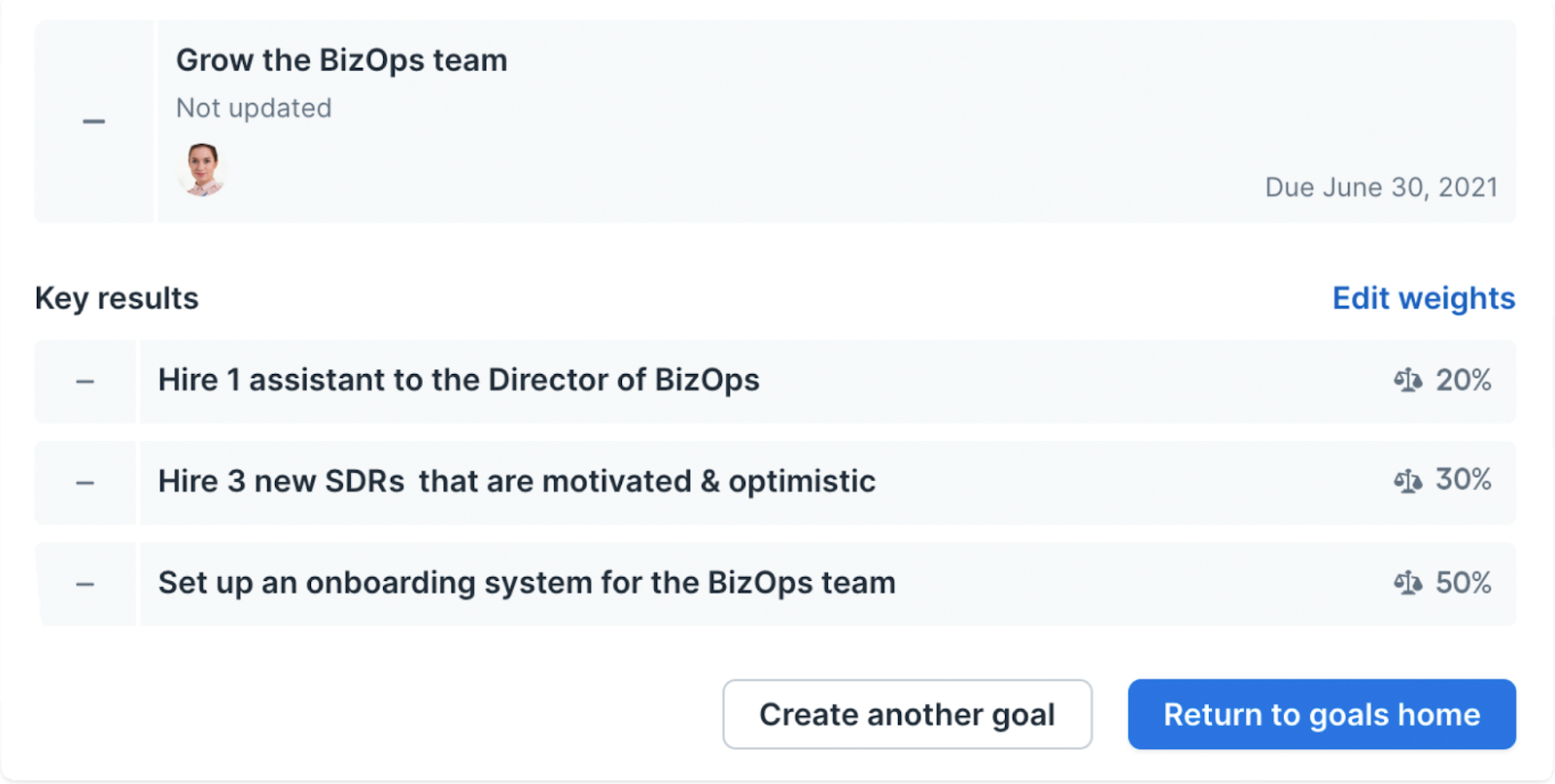
Weighing key results helps your team evaluate actions based on their actual level of importance in achieving objectives. Overall, this approach gives businesses greater control over how they measure progress on their goals and communicate their relative impact.
CADENCE
Business realities can change drastically in a matter of months, so waiting six months to discuss goals may not be an agile approach. At the same time, weekly OKRs might feel more like a task list than an overall goal-setting strategy. Setting quarterly OKRs gives businesses sufficient runway to accomplish their goals, while still keeping them time-bound. For support with building effective OKRs to meet your top priorities, download our free OKR template.
Over 50% of individual, team, and company goals have a timeline of 90 days or less, according to Lattice customer data.
Qualities of a Successful OKR
The OKR methodology distinguishes itself from other frameworks for setting goals with its unique approach to blending both ambition and practicality. It’s also designed to encourage company, team, and individual-level transparency and accountability.
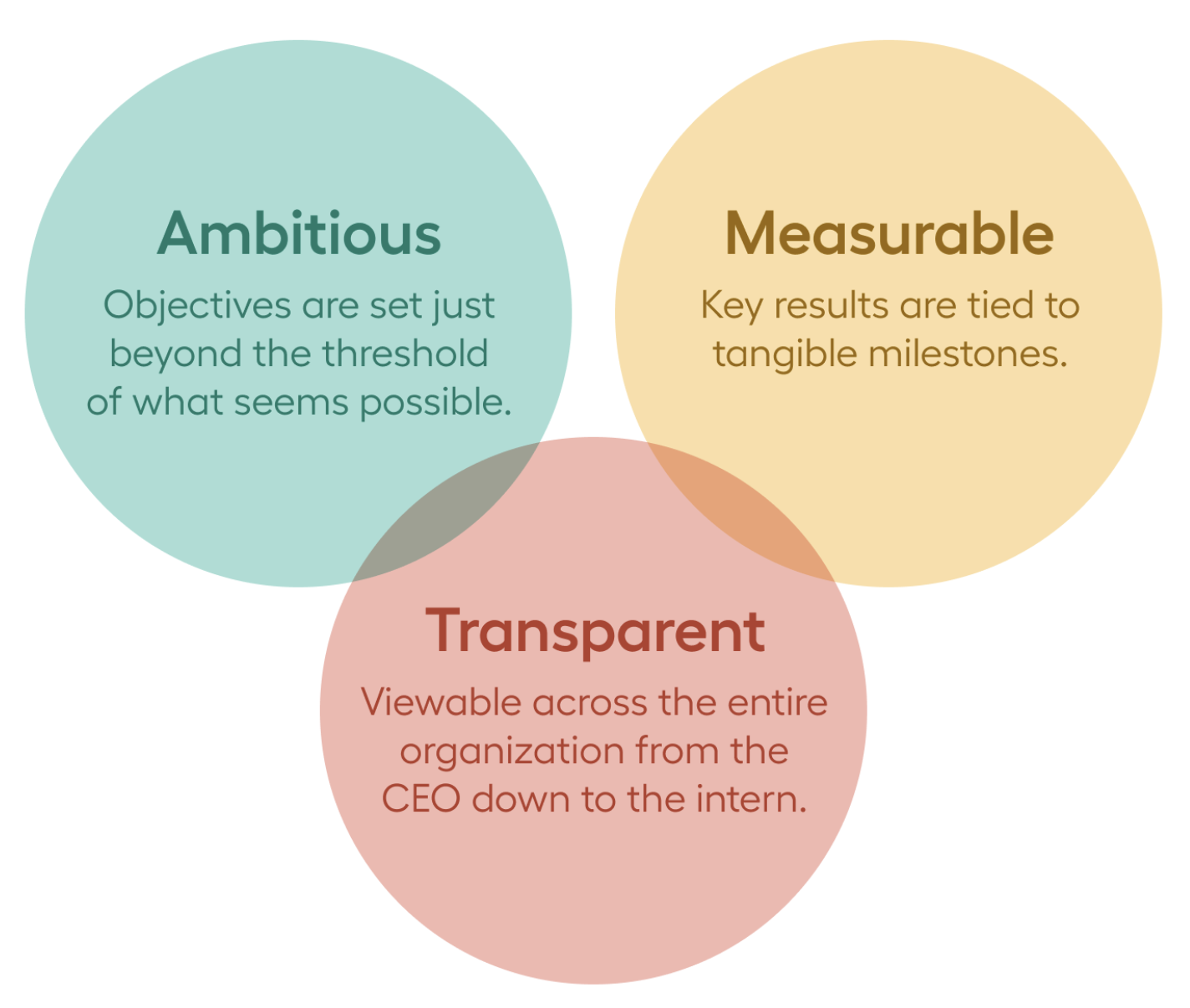
Objectives should be ambitious; inspirational targets tend to make people at all levels of your organization think bigger, such as stretch goals.
Key results should be measurable; giving company goals a finite endpoint allows businesses to accurately quantify progress when they reach a milestone.
OKRs should be transparent; visibility across organizations creates a sense of accountability, and gives teams context to make informed decisions.
A Step-by-Step Guide to Implementing OKRs
Goal setting isn't a one-size-fits-all process. When an organization sets out to launch an OKR program, there are several steps that need to be taken before, during, and after implementation.
1. Designing an OKRs Program
Organizations must identify how they will configure OKRs in their goal-setting system before launching so that they can design a process that suits their needs. Below we outline what businesses should consider before rolling out an OKRs program.
MISSION, VISION, & STRATEGY
Before implementing an OKR program, companies should clearly define the mission, vision, and business strategy that their OKRs can support. Your OKRs should be translated from your strategy, drive the achievement of your vision, and be in alignment with your overall mission.
OPERATIONS
A company's business context should dictate its approach to goal-setting. Before establishing OKRs, companies should evaluate different aspects of their day-to-day operations, such as headcount, organizational structure, legacy processes, project management capabilities, and more.
SYNCHRONIZATION
If you’re introducing OKRs to your company for the first time, a best practice is to launch without strict alignment and instead focus on directional alignment. Dependencies increase the likelihood of bottlenecks, so we recommend that companies avoid making things complicated.
OWNERSHIP
When HR teams are the sole driving force behind implementing and managing OKRs, it sends the message to the rest of the organization that OKRs are an administrative process. In order for an OKRs plan rollout to be successful, it needs to have public executive sponsorship.
2. Rolling Out Your OKRs Program
EMPLOYEE INVOLVEMENT
While it might not be feasible to have every employee involved in every part of the OKR process, employees should be clear on who is responsible for setting and tracking OKRs at each level, what projects and metrics they should prioritize, why the organization is introducing a new goal-setting process, and how their work connects to the business as a whole.
WORKFORCE TRAINING
Goal setting is a learned rather than innate skill, so organizations need to provide proper guidance to employees on how to set quality OKRs. Team meetings and workshops (for executives, managers, and employees) are a great way to support newcomers to the OKR methodology and, in subsequent cycles, encourage alignment across the organization.
ORGANIZATION
For companies of all sizes, tracking OKRs can be a challenging process. Organizations like Google have built internal tools. Others use ad hoc methods like spreadsheets, and a growing number of companies are using dedicated OKR software to keep company goals transparent and quantifiable.
3. Administering OKRs
GRADING OKRs
Grading is the process by which organizations objectively evaluate performance on OKRs. OKRs are graded on a scale between 0.0 to 1.0, as pictured below. Each key result is graded, and the average of the key results is used to create the grade for each corresponding objective.

If you're getting a perfect score on your OKRs all the time, that's a sign you should be setting more ambitious goals. Likewise, if you're consistently scoring below 0.3 on your goals, they’re probably too aspirational. OKRs shouldn’t be moonshots — consistently underperforming means it might be time to readjust your objectives and key results.
SHARING PROGRESS
OKR recap meetings are essential. At the beginning of every quarter, all levels of your organization should get together and discuss how they measured up to the OKRs set at the beginning of the previous goal cycle. Direct reports and managers should integrate OKRs into their one-on-one meetings.
INTEGRATING LEARNINGS
While grading is about objective measurement, learning is about contextualizing successes and shortcomings within a given OKR cycle to achieve better results moving forward. Evaluation of OKRs should happen regularly, but each cycle should also be capped by a retrospective conversation on what went well, what didn't go well, and what learnings can be applied to the next quarter’s roadmap.
OKR Examples
The following are some examples of effective OKRs. In each example, note how the objective is clear, ambitious, and aligned with an overall theme while the key results are measurable and designed to help accomplish the objective.
Company OKR
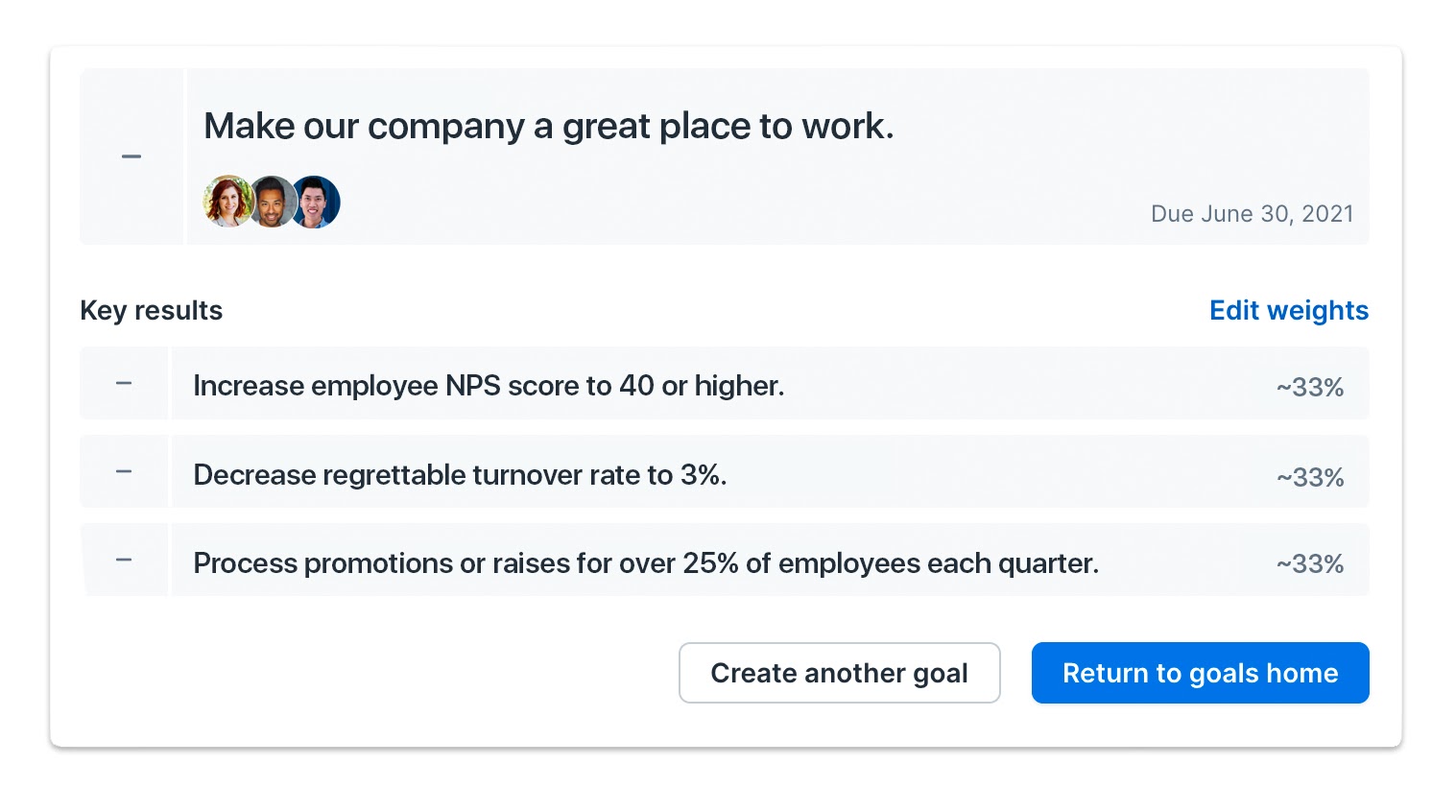
Team OKR
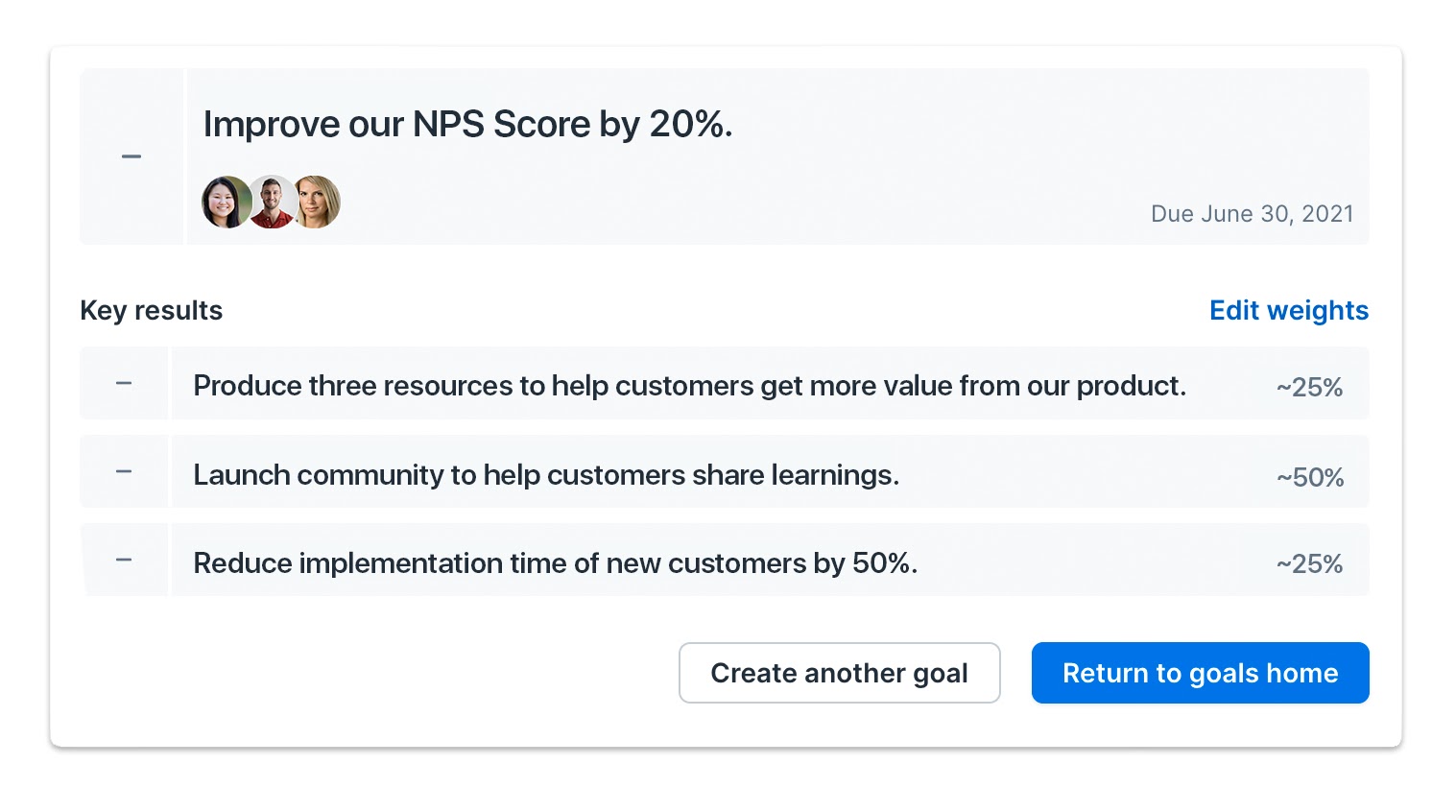
Individual OKR
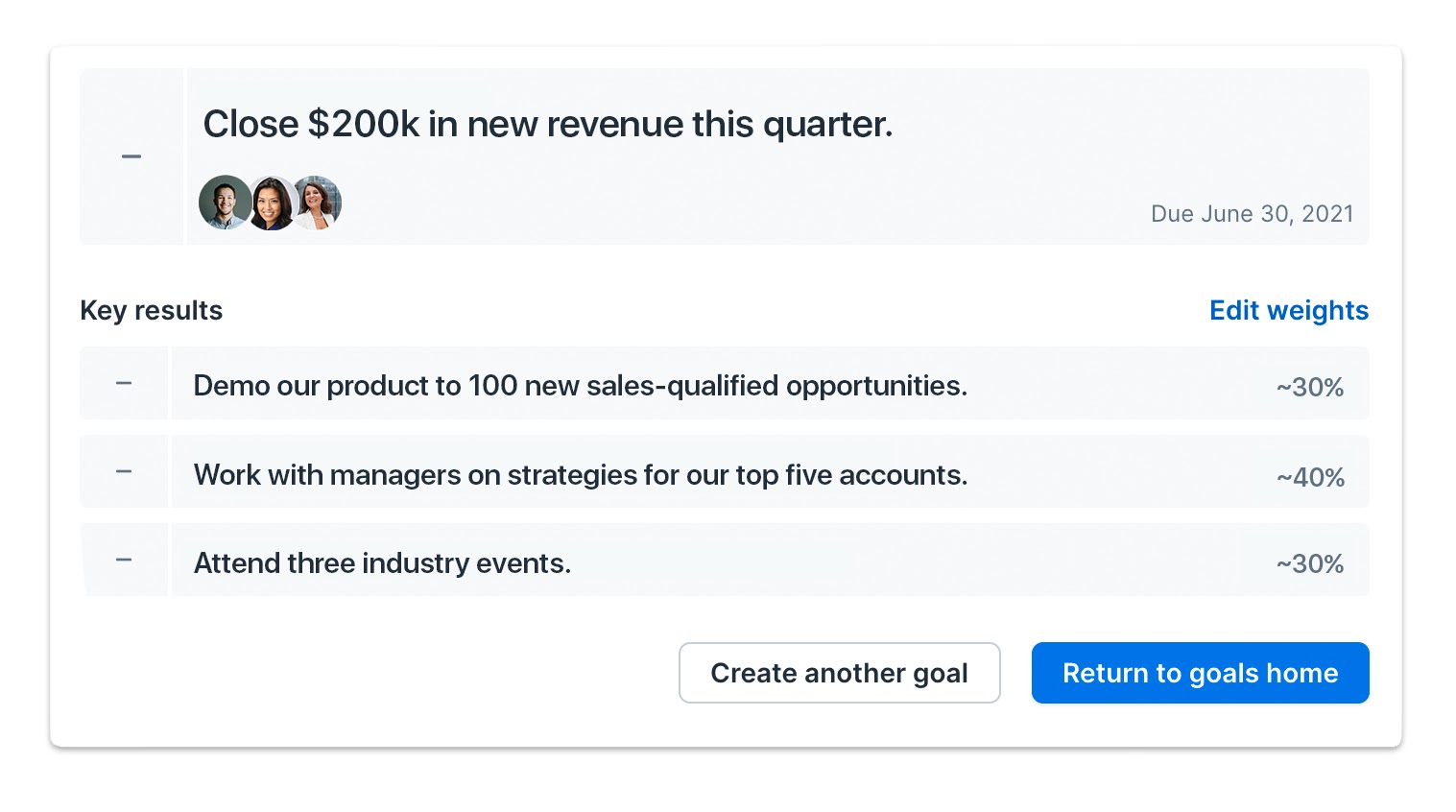
FAQ
Should OKRs focus on output or outcomes?
The purpose of OKRs is to redirect focus away from output and towards outcomes. The key difference between these two mindsets is that outcomes focus on what was achieved, whereas output focuses on how things are achieved.
Who should own a cross-functional objective?
As long as there is a clear delineation of responsibilities, it’s okay to give multiple parties ownership over the same goal if it’s truly a cross-functional priority for your business. However, if you find that all of your OKRs are being co-owned by multiple people, that usually is a sign that you need to break your objectives down into smaller key results.
How should OKRs be used in performance reviews?
Ultimately, this is a personal decision that every leadership team has to make for their own company. But regardless of what you decide, OKRs are not synonymous with employee performance evaluations, and companies who intend to connect OKRs to performance shouldn't do so in isolation. Rather, they should be integrating OKRs into a full review of all performance management aspects.
Final Tips
The OKRs framework is a powerful management tool for helping businesses define broader goals and the quantifiable actions that support them. Here are some final tips for getting OKRs to work for your company:
- Keep your OKRs flexible. Don’t obsess over alignment between levels.
- Use learnings from old OKRs to iterate and create new OKRs.
- Highlight executive sponsorship when rolling out OKRs plans.
- Set OKRs frequently –– ideally quarterly but at least every six months.
- Ensure OKRs are ambitious, measurable, and transparent.
- Leverage tools that make tracking OKRs easier and top-of-mind.
For more actionable tips and proven strategies for getting OKRs to work for your company, check out our Complete Guide to OKRs ebook.







